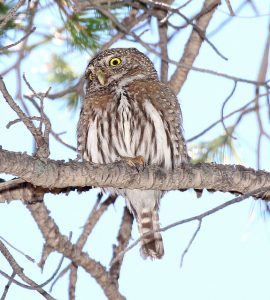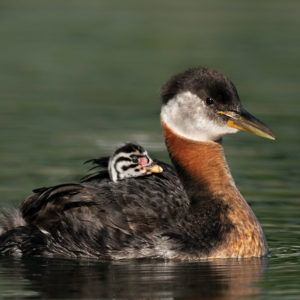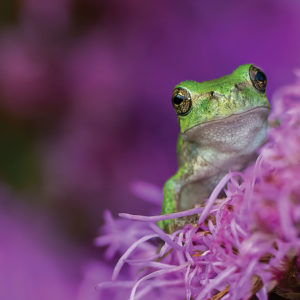Identify that Owl: The Silent Striker

Blair Scott,
Guest Blogger
This blog was written by guest blogger Blair Scott.
Brace yourself for November’s featured critter: The Northern Pygmy Owl (Glaucidium gnoma)!
If you plan on bird-watching in this little owl’s territory, bring yourself an extra set of eyes and be sure to focus carefully – you are likely being watched by this owl!
Weighing in at 62-73g and standing a mere 17cm high, we are talking about a very small, but watchful predator here! And I mean watchful – it has two pairs of eyes: piercing, yellow globes in the front and a set of big, black binoculars on the back of its head – well…fake, that is! During the course of its evolution, I think this owl may have taken the “360 degree view” a little too literally. Although, speculation suggests that it is a defense mechanism used against prey and predators alike.
Periodically, the Northern Pygmy Owl must put up with a pestering flock of curious chickadees and nuthatches as they ambitiously attempt to “mob” it. But frankly, small birds are amongst the staples of its diet – next to rodents and large insects. Specifically, it feasts on voles, mice, shrews and chipmunks; chickadees, hummingbirds and sparrows; as well as beetles, butterflies and dragonflies.
The call of this owl ranges from a soft, one-to-two-second-interval lullaby to a more agitated “staccato rhythm.” The standard melody of the Northern Pygmy Owl sounds somewhat like the chiming of a flute or recorder.
The Northern Pygmy Owl is puffy and compact with round heads devoid of ear tufts. Its plumage may be greyish-brown, rusty-brown or predominantly grey, decorated with white speckles. The owl has a white belly wisped with dark brown lines; a yellow beak and claws; a wingspan of 86-105mm and ruggedly-striped tail of 60-79mm in length. From afar, this owl may appear as a polka-dotted puffball with wings firmly glued to its body, and a rectangular tail poking out to one side. The Northern Saw-Whet Owl is similar in appearance, but can be distinguished by its large, asymmetrical head, darker brown colouring, shorter tail and absence of fake eyes on the back of its head.
Northern Pygmy Owls are diurnal hunters, meaning they are most active during dawn and dusk. They are known for being silent and attentive, waiting for prey to flock to them. Once a target has been spotted, they strike fiercely, often bringing the carcasses of their victims back to their dwelling (typically a coniferous tree perch or hollow). At times, airlifted casualties can be up to three times their own weight!
This owl resides along the western division of North America, favouring areas that strike a balance between forest openings and dense coverage. In Canada, it can be found year-round in the northern regions of British Columbia and southwestern portions of Alberta. During the fall and winter, it may drop to more southern points of these regions, but it does not carry out any extensive migration.
Although bird-watchers have the advantage of being able to find this owl during the daytime, its quiet nature and tiny figure makes it hard to find. If the sun is shining and there is still no sign of its “toot,” you can bet that the chipper peeping of a chickadee assembly may lead you to it!
However, like many birds, this owl depends on the availability of pre-excavated nesting cavities such as left-behind woodpecker holes and tree hollows. Keep dead trees living spaces for these creatures! For more information on the owls found in Canada, check out our e-Book series!



